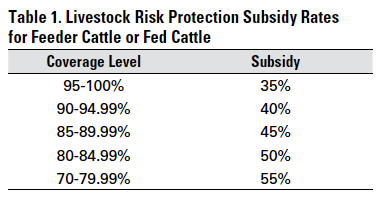Safeguarding Success: Bagley Risk Management Services
Safeguarding Success: Bagley Risk Management Services
Blog Article
Recognizing Livestock Threat Protection (LRP) Insurance Policy: A Comprehensive Guide
Navigating the realm of animals danger protection (LRP) insurance policy can be an intricate undertaking for several in the farming field. From just how LRP insurance works to the numerous insurance coverage choices available, there is much to uncover in this detailed guide that might potentially shape the means livestock producers approach risk administration in their companies.

How LRP Insurance Functions
Sometimes, recognizing the auto mechanics of Animals Threat Defense (LRP) insurance can be intricate, yet breaking down how it works can provide clearness for herdsmans and farmers. LRP insurance coverage is a risk monitoring tool made to shield animals manufacturers versus unexpected price decreases. The plan enables manufacturers to establish an insurance coverage degree based upon their particular needs, choosing the number of head, weight variety, and coverage rate. Once the policy is in place, if market value fall listed below the insurance coverage cost, producers can sue for the difference. It's essential to note that LRP insurance is not an earnings warranty; instead, it focuses entirely on rate danger security. The protection duration typically varies from 13 to 52 weeks, providing versatility for producers to select a duration that aligns with their manufacturing cycle. By making use of LRP insurance, farmers and breeders can reduce the monetary dangers linked with fluctuating market value, guaranteeing greater security in their operations.
Eligibility and Coverage Options

When it comes to protection options, LRP insurance provides producers the flexibility to select the protection degree, protection duration, and recommendations that ideal suit their danger monitoring requirements. By understanding the eligibility criteria and protection options available, livestock producers can make enlightened decisions to take care of threat successfully.
Benefits And Drawbacks of LRP Insurance Coverage
When examining Livestock Risk Protection (LRP) insurance, it is essential for livestock manufacturers to evaluate the benefits and downsides intrinsic in this threat management device.

Among the key benefits of LRP insurance is its ability to offer security against a decline in animals prices. This can assist safeguard manufacturers from monetary losses arising from market changes. Furthermore, LRP insurance coverage supplies a level of adaptability, permitting producers to tailor insurance coverage levels and plan durations to match their particular requirements. By securing a guaranteed price for their animals, manufacturers can much better handle risk and strategy for the future.
One limitation of LRP insurance is that it does not secure versus all kinds of threats, such as condition outbreaks or natural catastrophes. It is important for producers to meticulously analyze their individual risk direct exposure and financial circumstance to establish if LRP insurance coverage is the best risk administration device for their procedure.
Comprehending LRP Insurance Coverage Premiums

Tips for Optimizing LRP Conveniences
Optimizing the benefits of Animals Threat Security (LRP) insurance coverage calls for critical planning and proactive danger administration - Bagley Risk Management. To take advantage of your LRP coverage, consider the complying with ideas:
Routinely Evaluate Market Problems: Keep informed concerning market trends and price fluctuations in the livestock market. By monitoring i thought about this these aspects, you can make educated choices concerning when to purchase LRP insurance coverage to safeguard against prospective visit the website losses.
Establish Realistic Insurance Coverage Levels: When selecting insurance coverage degrees, consider your manufacturing costs, market value of livestock, and possible risks - Bagley Risk Management. Setting practical protection degrees ensures that you are effectively safeguarded without paying too much for unneeded insurance
Diversify Your Protection: Rather than relying solely on LRP insurance, consider expanding your danger monitoring approaches. Incorporating LRP with various other danger management devices such as futures agreements or choices can offer comprehensive protection against market uncertainties.
Review and Change Protection On a regular basis: As market conditions change, occasionally assess your LRP protection to ensure it straightens with your existing risk exposure. Adjusting insurance coverage levels and timing of purchases can assist enhance your threat defense technique. By complying with these suggestions, you can optimize the benefits of LRP insurance and safeguard your livestock operation versus unanticipated dangers.
Verdict
Finally, animals danger protection (LRP) insurance is a beneficial device for farmers to handle the economic threats connected with their animals procedures. By comprehending how LRP functions, eligibility and insurance coverage options, along with the advantages and disadvantages of this insurance coverage, farmers can make educated decisions to secure their livelihoods. By very carefully thinking about LRP premiums and executing approaches to make the most of benefits, farmers can minimize prospective losses and guarantee the sustainability of their procedures.
Animals manufacturers interested in getting Livestock Risk Security (LRP) insurance can discover a range of eligibility standards and insurance coverage choices customized to their particular livestock procedures.When it comes to protection choices, LRP insurance coverage supplies producers the versatility to select the protection level, protection period, and endorsements that finest match their threat administration requirements.To understand the complexities of Animals Risk Defense (LRP) insurance totally, understanding the aspects influencing LRP insurance policy premiums is crucial. LRP insurance policy premiums are identified by numerous elements, consisting of the protection level chosen, the expected cost of here livestock at the end of the protection period, the type of animals being guaranteed, and the length of the protection period.Testimonial and Readjust Insurance Coverage Routinely: As market conditions change, occasionally evaluate your LRP coverage to guarantee it straightens with your present danger direct exposure.
Report this page